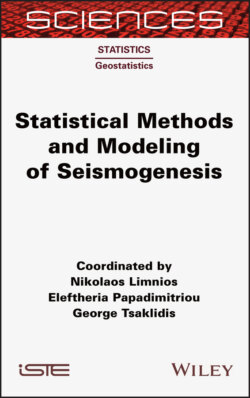Читать книгу Statistical Methods and Modeling of Seismogenesis - Eleftheria Papadimitriou - Страница 35
2.3.6. Further improvements of the simulator code (2019)
ОглавлениеIn the last version of the simulator, we introduced new features with the aim of achieving a more realistic physical modeling of the seismic process and a better similarity between real and synthetic catalogs. The first improvement in the new version of the algorithm is the modeling of the geometry of the seismic source by a trapezoidal shape, of which the old rectangles are a limit case. The rationale of this change is to allow a more accurate modeling of curve seismogenic structures, as described in the previous section, avoiding gaps between adjacent rectangular faults with different strikes. In the numerical application, the discretization of the trapezoidal shapes of the faults in square cells is obtained by retaining only the cells the centers of which are inside the trapeze edges. Note that modeling the seismic sources by numerous faults of rectangular or trapezoidal shape is just a convenient tool for the simplicity of the algorithm used in the physics-based simulator code, but in no way does it constitute a limitation to stop a rupture at the edges of such faults.
Then, we modified the algorithm for event nucleation, making use of the method described by Toda et al. (1998, 2005), based on the rate-and-state constitutive law introduced by Dieterich (1994). Here, in the following, are the basic principles of the model. Every cell of the fault system is characterized by the instantaneous value of its state variable γ. The expected rate r of failure of each cell in a population of a large number of identical cells is inversely proportional to γ as
[2.1]
where γ0 and r0 are the unperturbed steady-state values of γ and r. Here r0 is the rate of events of magnitude exceeding the threshold adopted in the simulation. It is obtained by dividing the slip rate of each fault segment in the seismogenic model by the slip pertaining to an event of average magnitude, assuming a G-R magnitude distribution with b = 1, for events of magnitude exceeding the threshold. Every cell changes its stress status and consequently the values of γ and r when an event occurs not very far in the fault system. The coseismic Coulomb stress change ΔCFF on the receiving cell is computed by:
[2.2]
where Δτ and Δσn are, respectively, the shear and the normal components of the stress change tensor inverted according to the focal mechanism of the receiver fault, and μ′ is the effective coefficient of friction, assumed equal to 0.4. Note that equation [2.2] is computed adding the contribution of all cells ruptured in the causative event, with their respective coseismic slip. According to the rate-and-state model (Toda et al. 1998, 2005), the rate r′ of failure after a time t from the causative event for the receiving cell is given by:
[2.3]
where r0 is the background rate introduced in equation [2.1], r is the rate of failure just before the causative event, Aσ is a constant parameter of the constitutive law and ta is the characteristic decay time given by:
[2.4]
where is the stress rate (proportional to the slip rate) relative to the fault segment to which the receiving cell belongs. After an event is stored in the output synthetic catalog, the simulator code makes use of equation [2.3] to define the coordinates and occurrence time of a cell where the next event will be nucleated, in the following iterative way. An updated flow chart of this procedure is shown in Figure 2.13.
Figure 2.13. Flow chart of the computer code for earthquake simulation with rate-and-state constitutive law nucleation mechanism. S&R: rate-state dependent friction; DCFF: Coulomb failure function change; THR: threshold; RED: reduction. For a color version of this figure, see www.iste.co.uk/limnios/statistical.zip
Suppose that the current latest event occurred at the origin time t0. The expected number N of new events in the time interval t0 + Δt < t < t0 + 1.5Δt can be obtained for all the cells of the fault system by integration from Δt to 1.5Δt by the occurrence rate of equation [2.3], starting with a very small Δt time interval (e.g. 1 second). Here, the integration is approximated by multiplying the occurrence rate at time 1.25 Δt by 0.5 Δt. After a strong event, the cells with large positive ΔCFF will have high rates, and the cells with large negative ΔCFF will have low rates. The probability of at least one event occurring in the Δt time interval is given by 1 –exp(–N) on the basis of a Poisson distribution. If a cell exists where the probability exceeds a random number uniformly distributed between 0 and 1, that cell is assigned as the nucleation point for a new event and its occurrence time is assigned a value randomly distributed between t0 + Δt and t0 + 1.5Δt, otherwise new probabilities are computed, increasing Δt by a factor of 1.5 and compared with random numbers. If more than one cell fulfills the criterion of exceedance of the random number, the cell with the largest probability is assumed as the nucleation cell. The process is repeated until the condition of exceedance for the probability in any of the cells is met and the rupture of a new event starts. According to equation [2.3], after the rate change caused by an event, if no other perturbation happens, the rate r gradually returns to the background rate r0. By the application of this algorithm in the new version of the simulator, the nucleation point and occurrence time for events is determined randomly by a stochastic procedure, rather than by a deterministic rule. As it will be shown later, the synthetic catalogs obtained using this new algorithm proved to contain realistic features of event clustering after strong events, not achieved by the previous versions.
